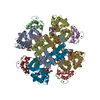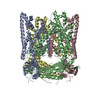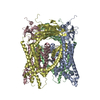+ データを開く
データを開く
- 基本情報
基本情報
| 登録情報 | データベース: PDB / ID: 6v01 | |||||||||
|---|---|---|---|---|---|---|---|---|---|---|
| タイトル | structure of human KCNQ1-KCNE3-CaM complex with PIP2 | |||||||||
 要素 要素 |
| |||||||||
 キーワード キーワード | MEMBRANE PROTEIN / potassium channel / KCNQ1 / CaM | |||||||||
| 機能・相同性 |  機能・相同性情報 機能・相同性情報negative regulation of membrane repolarization during ventricular cardiac muscle cell action potential / gastrin-induced gastric acid secretion / corticosterone secretion / voltage-gated potassium channel activity involved in atrial cardiac muscle cell action potential repolarization / basolateral part of cell / voltage-gated potassium channel activity involved in cardiac muscle cell action potential repolarization / lumenal side of membrane / negative regulation of voltage-gated potassium channel activity / rhythmic behavior / negative regulation of potassium ion export across plasma membrane ...negative regulation of membrane repolarization during ventricular cardiac muscle cell action potential / gastrin-induced gastric acid secretion / corticosterone secretion / voltage-gated potassium channel activity involved in atrial cardiac muscle cell action potential repolarization / basolateral part of cell / voltage-gated potassium channel activity involved in cardiac muscle cell action potential repolarization / lumenal side of membrane / negative regulation of voltage-gated potassium channel activity / rhythmic behavior / negative regulation of potassium ion export across plasma membrane / regulation of gastric acid secretion / stomach development / membrane repolarization during atrial cardiac muscle cell action potential / iodide transport / Phase 3 - rapid repolarisation / membrane repolarization during action potential / regulation of atrial cardiac muscle cell membrane repolarization / Phase 2 - plateau phase / intracellular chloride ion homeostasis / membrane repolarization during ventricular cardiac muscle cell action potential / membrane repolarization during cardiac muscle cell action potential / negative regulation of delayed rectifier potassium channel activity / renal sodium ion absorption / potassium ion export across plasma membrane / atrial cardiac muscle cell action potential / detection of mechanical stimulus involved in sensory perception of sound / auditory receptor cell development / voltage-gated potassium channel activity involved in ventricular cardiac muscle cell action potential repolarization / regulation of membrane repolarization / protein phosphatase 1 binding / positive regulation of potassium ion transmembrane transport / delayed rectifier potassium channel activity / Voltage gated Potassium channels / non-motile cilium assembly / potassium ion homeostasis / ventricular cardiac muscle cell action potential / outward rectifier potassium channel activity / regulation of ventricular cardiac muscle cell membrane repolarization / cardiac muscle cell contraction / CaM pathway / intestinal absorption / Cam-PDE 1 activation / Sodium/Calcium exchangers / Calmodulin induced events / inner ear morphogenesis / Reduction of cytosolic Ca++ levels / CREB1 phosphorylation through the activation of CaMKII/CaMKK/CaMKIV cascasde / Activation of Ca-permeable Kainate Receptor / Loss of phosphorylation of MECP2 at T308 / CREB1 phosphorylation through the activation of Adenylate Cyclase / PKA activation / negative regulation of high voltage-gated calcium channel activity / monoatomic ion channel complex / ciliary base / CaMK IV-mediated phosphorylation of CREB / Glycogen breakdown (glycogenolysis) / positive regulation of cyclic-nucleotide phosphodiesterase activity / organelle localization by membrane tethering / negative regulation of calcium ion export across plasma membrane / CLEC7A (Dectin-1) induces NFAT activation / regulation of heart contraction / autophagosome membrane docking / mitochondrion-endoplasmic reticulum membrane tethering / Activation of RAC1 downstream of NMDARs / positive regulation of heart rate / regulation of cardiac muscle cell action potential / sodium ion transport / adrenergic receptor signaling pathway / cochlea development / renal absorption / action potential / positive regulation of ryanodine-sensitive calcium-release channel activity / neuronal cell body membrane / regulation of cell communication by electrical coupling involved in cardiac conduction / Synthesis of IP3 and IP4 in the cytosol / negative regulation of peptidyl-threonine phosphorylation / protein kinase A regulatory subunit binding / Negative regulation of NMDA receptor-mediated neuronal transmission / Phase 0 - rapid depolarisation / potassium ion import across plasma membrane / Unblocking of NMDA receptors, glutamate binding and activation / negative regulation of ryanodine-sensitive calcium-release channel activity / regulation of heart rate by cardiac conduction / protein kinase A catalytic subunit binding / protein phosphatase activator activity / RHO GTPases activate PAKs / Ion transport by P-type ATPases / : / inner ear development / Uptake and function of anthrax toxins / social behavior / Long-term potentiation / Regulation of MECP2 expression and activity / Calcineurin activates NFAT / voltage-gated potassium channel activity / catalytic complex / DARPP-32 events / detection of calcium ion / regulation of cardiac muscle contraction / Smooth Muscle Contraction 類似検索 - 分子機能 | |||||||||
| 生物種 |  Homo sapiens (ヒト) Homo sapiens (ヒト) | |||||||||
| 手法 | 電子顕微鏡法 / 単粒子再構成法 / クライオ電子顕微鏡法 / 解像度: 3.9 Å | |||||||||
 データ登録者 データ登録者 | Mackinnon, R. / Sun, J. | |||||||||
| 資金援助 |  米国, 2件 米国, 2件
| |||||||||
 引用 引用 |  ジャーナル: Cell / 年: 2020 ジャーナル: Cell / 年: 2020タイトル: Structural Basis of Human KCNQ1 Modulation and Gating. 著者: Ji Sun / Roderick MacKinnon /  要旨: KCNQ1, also known as Kv7.1, is a voltage-dependent K channel that regulates gastric acid secretion, salt and glucose homeostasis, and heart rhythm. Its functional properties are regulated in a tissue- ...KCNQ1, also known as Kv7.1, is a voltage-dependent K channel that regulates gastric acid secretion, salt and glucose homeostasis, and heart rhythm. Its functional properties are regulated in a tissue-specific manner through co-assembly with beta subunits KCNE1-5. In non-excitable cells, KCNQ1 forms a complex with KCNE3, which suppresses channel closure at negative membrane voltages that otherwise would close it. Pore opening is regulated by the signaling lipid PIP2. Using cryoelectron microscopy (cryo-EM), we show that KCNE3 tucks its single-membrane-spanning helix against KCNQ1, at a location that appears to lock the voltage sensor in its depolarized conformation. Without PIP2, the pore remains closed. Upon addition, PIP2 occupies a site on KCNQ1 within the inner membrane leaflet, which triggers a large conformational change that leads to dilation of the pore's gate. It is likely that this mechanism of PIP2 activation is conserved among Kv7 channels. | |||||||||
| 履歴 |
|
- 構造の表示
構造の表示
| ムービー |
 ムービービューア ムービービューア |
|---|---|
| 構造ビューア | 分子:  Molmil Molmil Jmol/JSmol Jmol/JSmol |
- ダウンロードとリンク
ダウンロードとリンク
- ダウンロード
ダウンロード
| PDBx/mmCIF形式 |  6v01.cif.gz 6v01.cif.gz | 367.8 KB | 表示 |  PDBx/mmCIF形式 PDBx/mmCIF形式 |
|---|---|---|---|---|
| PDB形式 |  pdb6v01.ent.gz pdb6v01.ent.gz | 286.9 KB | 表示 |  PDB形式 PDB形式 |
| PDBx/mmJSON形式 |  6v01.json.gz 6v01.json.gz | ツリー表示 |  PDBx/mmJSON形式 PDBx/mmJSON形式 | |
| その他 |  その他のダウンロード その他のダウンロード |
-検証レポート
| 文書・要旨 |  6v01_validation.pdf.gz 6v01_validation.pdf.gz | 1.1 MB | 表示 |  wwPDB検証レポート wwPDB検証レポート |
|---|---|---|---|---|
| 文書・詳細版 |  6v01_full_validation.pdf.gz 6v01_full_validation.pdf.gz | 1.1 MB | 表示 | |
| XML形式データ |  6v01_validation.xml.gz 6v01_validation.xml.gz | 58.6 KB | 表示 | |
| CIF形式データ |  6v01_validation.cif.gz 6v01_validation.cif.gz | 80.3 KB | 表示 | |
| アーカイブディレクトリ |  https://data.pdbj.org/pub/pdb/validation_reports/v0/6v01 https://data.pdbj.org/pub/pdb/validation_reports/v0/6v01 ftp://data.pdbj.org/pub/pdb/validation_reports/v0/6v01 ftp://data.pdbj.org/pub/pdb/validation_reports/v0/6v01 | HTTPS FTP |
-関連構造データ
- リンク
リンク
- 集合体
集合体
| 登録構造単位 | 
|
|---|---|
| 1 |
|
- 要素
要素
| #1: タンパク質 | 分子量: 16852.545 Da / 分子数: 4 / 由来タイプ: 組換発現 / 由来: (組換発現)  Homo sapiens (ヒト) / 遺伝子: CALM1, CALM, CAM, CAM1 / 発現宿主: Homo sapiens (ヒト) / 遺伝子: CALM1, CALM, CAM, CAM1 / 発現宿主:  Homo sapiens (ヒト) / 参照: UniProt: P0DP23 Homo sapiens (ヒト) / 参照: UniProt: P0DP23#2: タンパク質 | 分子量: 11725.399 Da / 分子数: 4 / 由来タイプ: 組換発現 / 由来: (組換発現)  Homo sapiens (ヒト) / 遺伝子: KCNE3 / 発現宿主: Homo sapiens (ヒト) / 遺伝子: KCNE3 / 発現宿主:  Homo sapiens (ヒト) / 参照: UniProt: Q9Y6H6, UniProt: X5DSL3*PLUS Homo sapiens (ヒト) / 参照: UniProt: Q9Y6H6, UniProt: X5DSL3*PLUS#3: タンパク質 | 分子量: 63258.574 Da / 分子数: 4 / 由来タイプ: 組換発現 / 由来: (組換発現)  Homo sapiens (ヒト) / 遺伝子: KCNQ1, KCNA8, KCNA9, KVLQT1 / 発現宿主: Homo sapiens (ヒト) / 遺伝子: KCNQ1, KCNA8, KCNA9, KVLQT1 / 発現宿主:  Homo sapiens (ヒト) / 参照: UniProt: P51787 Homo sapiens (ヒト) / 参照: UniProt: P51787#4: 化合物 | ChemComp-CA / #5: 化合物 | ChemComp-PT5 / [( 研究の焦点であるリガンドがあるか | Y | |
|---|
-実験情報
-実験
| 実験 | 手法: 電子顕微鏡法 |
|---|---|
| EM実験 | 試料の集合状態: PARTICLE / 3次元再構成法: 単粒子再構成法 |
- 試料調製
試料調製
| 構成要素 | 名称: KCNQ1-CaM complex / タイプ: COMPLEX / Entity ID: #1-#3 / 由来: RECOMBINANT |
|---|---|
| 分子量 | 実験値: NO |
| 由来(天然) | 生物種:  Homo sapiens (ヒト) Homo sapiens (ヒト) |
| 由来(組換発現) | 生物種:  Homo sapiens (ヒト) Homo sapiens (ヒト) |
| 緩衝液 | pH: 7.4 |
| 試料 | 包埋: NO / シャドウイング: NO / 染色: NO / 凍結: YES |
| 急速凍結 | 凍結剤: ETHANE |
- 電子顕微鏡撮影
電子顕微鏡撮影
| 実験機器 |  モデル: Titan Krios / 画像提供: FEI Company |
|---|---|
| 顕微鏡 | モデル: FEI TITAN KRIOS |
| 電子銃 | 電子線源:  FIELD EMISSION GUN / 加速電圧: 300 kV / 照射モード: FLOOD BEAM FIELD EMISSION GUN / 加速電圧: 300 kV / 照射モード: FLOOD BEAM |
| 電子レンズ | モード: BRIGHT FIELD |
| 撮影 | 電子線照射量: 94 e/Å2 フィルム・検出器のモデル: GATAN K2 SUMMIT (4k x 4k) |
- 解析
解析
| ソフトウェア | 名称: PHENIX / バージョン: 1.14_3260: / 分類: 精密化 |
|---|---|
| EMソフトウェア | 名称: RELION / カテゴリ: 3次元再構成 |
| CTF補正 | タイプ: NONE |
| 3次元再構成 | 解像度: 3.9 Å / 解像度の算出法: FSC 0.143 CUT-OFF / 粒子像の数: 73640 / 対称性のタイプ: POINT |
| 原子モデル構築 | プロトコル: AB INITIO MODEL |
 ムービー
ムービー コントローラー
コントローラー














 PDBj
PDBj



























